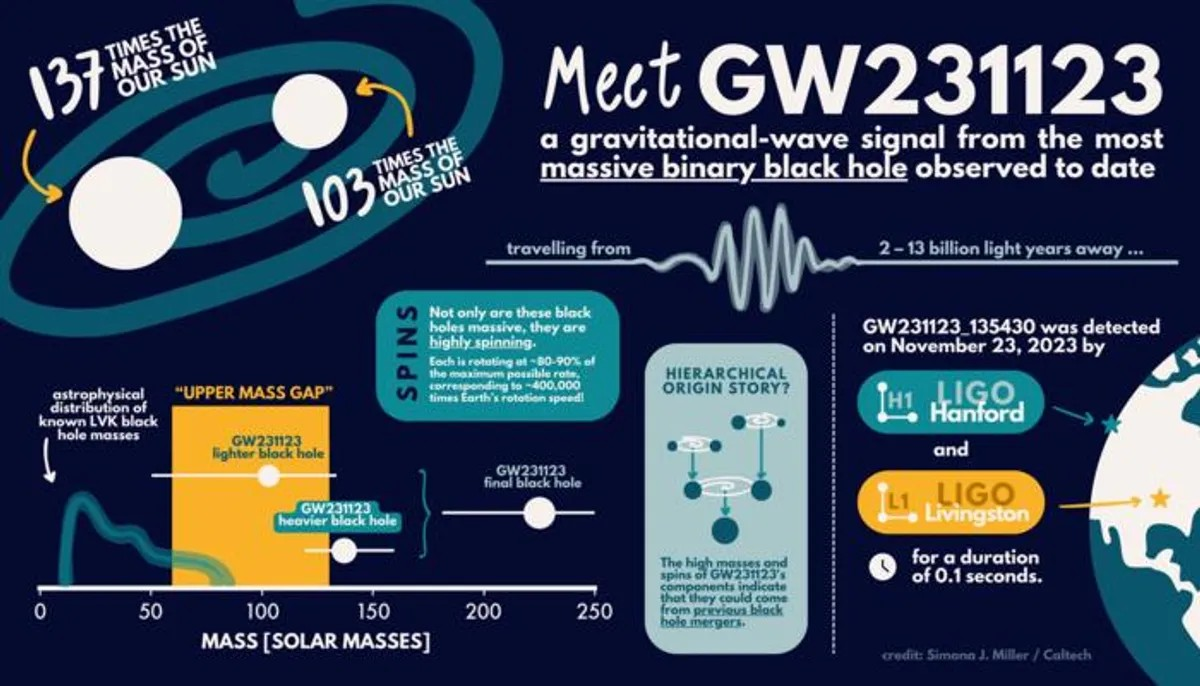A physics conference has received a report of the gravitational wave from the heaviest pair of black holes we’ve so far observed merging. The result is larger than theoretical models allow through straight-forward means, implying either a very complex prelude, or some astronomical phenomenon we don’t currently know about.
In 2016 when the gravitational wave from two black holes merging was first detected it was one of the most exciting events in astronomy for decades. These days, an event like that has become routine, thanks to improvements in equipment sensitivity, with more than 300 confirmed or under assessment.
Nevertheless, some detections can still cause ripples of interest in the fabric of the astronomical community to match those the merge makes in space-time continuum. In particular, bigger is better when it comes to what we can learn from merging events, so breaking the record for black hole mass induces a thrill.
The latest discovery, dubbed GW231123, comfortably exceeds expectations.
GW231123 apparently involved the merger of a black hole a 103 times the mass of the Sun with one 137 solar masses to create a giant of 225 solar masses. The missing estimated 15 solar masses was converted into energy, including the gravitational wave that alerted us to the event. The distance to the event is quite uncertain, anything from 700 million to 4.1 billion light years.
“This is the most massive black hole binary we’ve observed through gravitational waves, and it presents a real challenge to our understanding of black hole formation,” said Professor Mark Hannam of Cardiff University in a statement. “Black holes this massive are forbidden through standard stellar evolution models.”

Everything you needed to know about the largest black hole merger detected and its gravitational wave.
Image Credit: Simona J. Miller/Caltech
Supermassive black holes at the center of galaxies can have masses 100 billion times the Sun and millions of solar masses are common. However, the stellar black holes left behind when stars go supernova, whose mergers create the gravitational waves we detect, are much smaller.
Although stars with masses more than 200 times the Sun’s exist today in nearby galaxies, and far more massive ones were present in the early universe, a substantial portion of that mass is thrown off when a black hole is created. The minimum mass required for a star to become a black hole is about 25 solar masses, but the smallest black holes we find have masses of three solar masses, because so much is lost in the explosion. Moreover, once stars exceed 140 solar masses they are thought not to leave a black hole behind at all, so violent is the explosion.
In 2018, finding a merger with an 80 solar mass product, was considered significant for its size. This has since been exceeded by GW190521, with a combined mass 142 times that of the Sun. Even that puzzled astronomers, with suggestions it might have involved something more exotic than black holes, so it’s not hard to see why GW231123’s size has them scratching their heads.
“One possibility is that the two black holes in this binary formed through earlier mergers of smaller black holes,” Hannan said.
That’s easy to understand, but it would take some remarkable circumstances to make it happen. Most stars exist as binaries, and when both stars in pair are large enough to become black holes their orbits can eventually decay so the products spiral into each other. Four-star systems are not unknown, but they are a great deal rarer. Moreover, to make the larger of the two black holes that took part in this merger, more than two predecessors would probably have been required, Could so many giant stars have been crowded together into one system?
Besides their mass, the black holes involved in GW231123 spun particularly fast, making the event harder to detect, and also to explain. “The black holes appear to be spinning very rapidly—near the limit allowed by Einstein’s theory of general relativity,” explained Dr Charlie Hoy at the University of Portsmouth. “That makes the signal difficult to model and interpret. It’s an excellent case study for pushing forward the development of our theoretical tools.”
Members of the team involved acknowledge that once again we may be looking at some phenomenon we have not seen before, cosplaying as black holes, although they consider all possibilities
GW231123 was detected as part of the fourth observing run conducted in 2023-2024 by the collaboration of the LIGO, VIRGO and KAGRA gravitational wave detectors. Most of the data from that run will be released within a few months after the teams involved have finished processing it to remove errors.
However, details of GW231123 were presented in Glasgow at a meeting combining two longstanding gravitational wave conferences under the name GR-Amaldi. The event will see the first performance of a new Scottish Country dance (ceilidh) choreographed to represent the way black hole pairs form and spiral into each other, with participants encouraged to “whoop” to signal the release of the gravitational wave.
“Our plan once the ceilidh has been performed for the first time at GR–Amaldi is to take it on the road and to continue to develop it with educators, youth workers and local youth groups to help young people understand gravitational waves through dance and bring their own creativity and curiosity to build on it,” said Glasgow University’s Lewis Hou in a statement. Perhaps a future entrant for Dance your PhD?
A preprint of a paper reporting GW231123 is available on ArXiv.org but yet to be peer reviewed.
Source Link: Gravitational Wave Detected From Largest Black Hole Merger Yet: "It Presents A Real Challenge To Our Understanding Of Black Hole Formation"